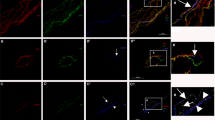Summary
The innervation of human axillary sweat glands was studied by using the specific SPG (sucrose-potassium phosphate-glyoxylic acid) catecholamine histofluorescence method and the peroxidase-antiperoxidase (PAP) immunocytochemical method. The present results demonstrated that human sweat glands are surrounded by nerves containing a weak tyrosine hydroxylase activity. Nerves showing catecholamine histofluorescence could be visualized around the sweat glands only in the presence of exogenous catecholamine (adrenaline in the local anestheticum). In all tissue specimens studied fluorescent adrenergic nerves could be seen around arteries and arterioles corresponding to the distribution of neuropeptide Y-like immunoreactive nerves.
Similar content being viewed by others
References
Björklund H, Hökfelt T, Goldstein M, Terenius L, Olson L (1985) Appearance of the noradrenergic markers tyrosine hydroxylase and neuropeptide Y in cholinergic nerves of the iris following sympathectomy. J Neurosci 5:1633–1643
Dale HH, Feldberg W (1934) The chemical transmission of secretory impulses to the sweat glands of the cat. J Physiol 82:121–128
Hartschuh W, Weihe E, Reinecke M (1983) Peptidergic (neurotensin, VIP, substance P) nerve fibers in the skin. Immunohistochemical evidence for an involvement of neuropeptides in nociception, pruritus and inflammation. Br J Dermatol 109 (Suppl 25):14–17
Hartschuh W, Reinecke M, Weihe E, Yanaihara N (1984) VIP-immunoreactivity in the skin of various mammals: Immunohistochemical, radioimmunological and experimental evidence for a dual localization in cutaneous nerves and Merkel cells. Peptides 5:239–254
Landis SC (1983) Development of cholinergic sympathetic neurons: evidence for transmitter plasticity in vivo. Fed Proc 42:1633–1638
Landis SC, Keefe D (1983) Evidence for neurotransmitter plasticity in vivo: Developmental changes in properties of cholinergic sympathetic neurons. Dev Biol 98:349–372
Lundberg JM, Hökfelt T, Schultzberg M, Uvnäs-Wallenstein K, Köhler C, Said SI (1979) Occurrence of vasoactive intestinal polypeptide (VIP)-like immunoreactivity in certain cholinergic neurons of the cat: Evidence from combined immunohistochemistry and acetylcholinesterase staining. Neuroscience 4:1539–1559
Lundberg JM, Terenius L, Hökfelt T, Martling CR, Tatemoto K, Mutt V, Polak J, Bloom S, Goldstein M (1982) Neuropeptide Y (NPY)-like immunoreactivity in peripheral noradrenergic neurons and effects of NPY on sympathetic function. Acta Physiol Scand 116:477–480
Lundberg JM, Saria A, Änggård A, Hökfelt T, Terenius L (1984) Neuropeptide Y and noradrenaline interaction in peripheral cardiovascular control. Clin Exp Hypertens (A) 6:1961–1972
Mazurkiewicz JE, Nakane PK (1972) Light and electron microscopic localization of antigens in tissue embedded in polyethylene glycol with a peroxidase labelled antibody method. J Histochem Cytochem 20:969–974
Pickel VM, Joh TH, Reis DJ, Leeman SE, Miller RJ (1979) Electron microscopic localization of substance P and enkephalin in axon terminals related to dendrites of catecholaminergic neurons. Brain Res 160:387–400
Rechardt L, Waris T, Rintala A (1976) Innervation of human axillary sweat glands. Scand J Plast Reconstr Surg 10:107–112
Siegel RE, Schwab M, Landis SC (1982) Developmental changes in the neurotransmitter properties of cholinergic sympathetic neurons in vivo. Soc Neurosci Abstr 8:7
Sokolov VE, Shabadash SA, Zelikina TI (1981) Innervation of the eccrine sweat glands. Biol Bull Acad Sci USSR 7:331–346
Sokolov VE, Shabadash SA, Zelikina TI (1982) Innervation of the apocrine sweat glands. Biol Bull Acad Sci USSR 8:242–254
Sternberger LA (1979) Immunohistochemistry. 2nd edn. John Wiley & Sons, New York
Sternini C, Brecha N (1985) Distribution and colocalization of neuropeptide Y- and tyrosine hydroxylase-like immunoreactivity in the guinea-pig heart. Cell Tissue Res 241:93–102
Tatemoto K (1982) Neuropeptide Y. The complete amino acid sequence of the brain peptide. Proc Natl Acad Sci USA 79:5485–5489
Torre JC de la (1980) An improved approach to histofluorescence using the SPG method for tissue monoamines. J Neurosci Methods 3:1–5
Uno H (1977) Sympathetic innervation of the sweat glands and piloerector muscles of macaques and human beings. J Invest Dermatol 69:112–120
Vaalasti A, Tainio H, Rechardt L (1985) Vasoactive intestinal polypeptide (VIP)-like immunoreactivity in the nerves of human axillary sweat glands. J Invest Dermatol 85:246–248
Author information
Authors and Affiliations
Rights and permissions
About this article
Cite this article
Tainio, H., Vaalasti, A. & Rechardt, L. The distribution of sympathetic adrenergic, tyrosine hydroxylase- and neuropeptide Y-immunoreactive nerves in human axillary sweat glands. Histochemistry 85, 117–120 (1986). https://doi.org/10.1007/BF00491757
Accepted:
Issue Date:
DOI: https://doi.org/10.1007/BF00491757



